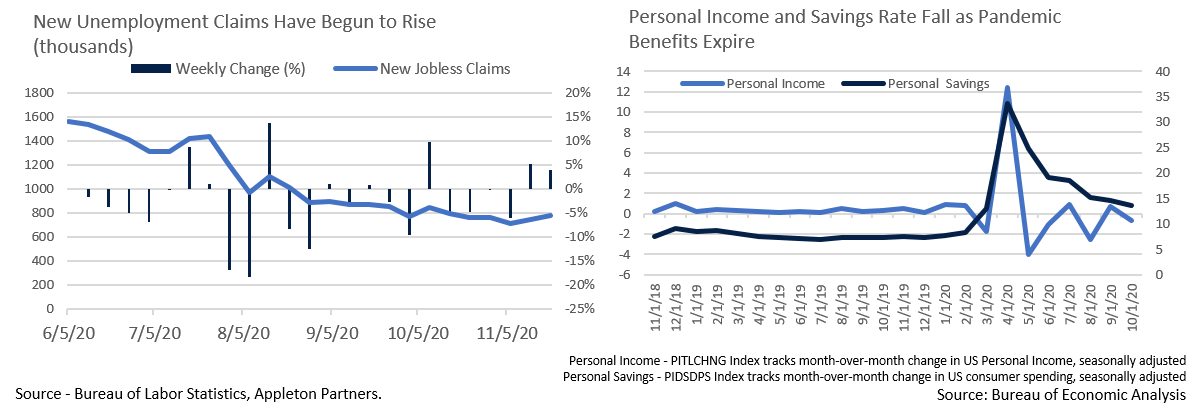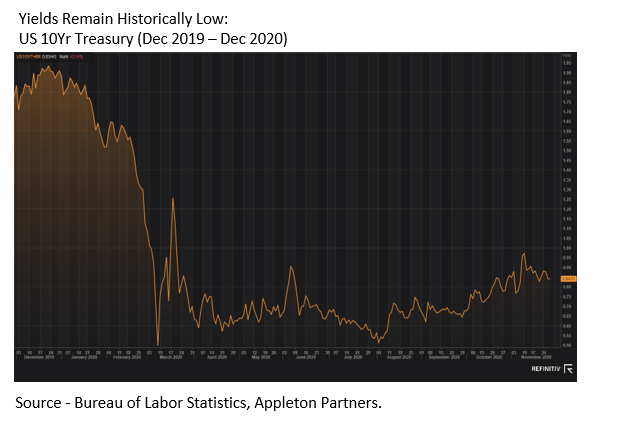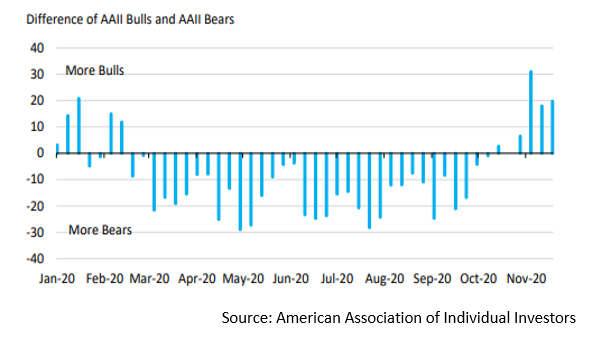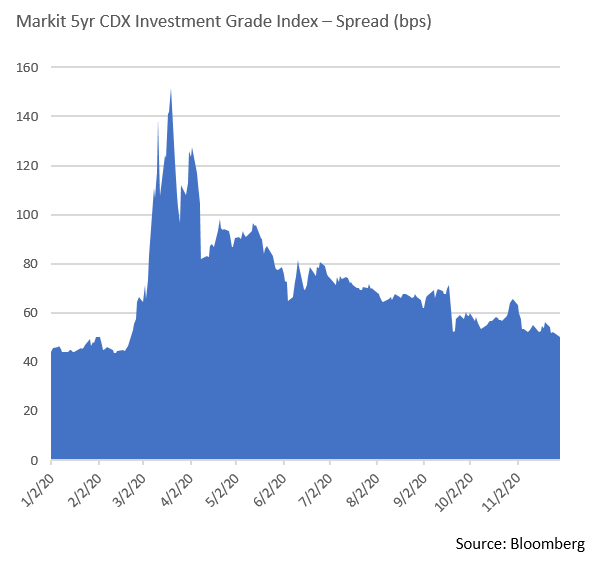Insights and Observations
Economic, Public Policy, and Fed Developments
- After a delay, the 2020 Presidential Election was eventually called for Democratic candidate Joseph Biden by a comfortable margin, and on November 23rd the GSA began the formal transition process. Meanwhile, although recounts continue, Democrats lost House seats and are projected to hold a razor thin majority. Control of the Senate hinges on two Georgia runoffs in January. Regardless, the margin of control will have been reduced as the Democrats have already picked up at least one seat. All told, a smaller House majority increases the power residing with the Progressive wing of the caucus, while moderate Democrats and Republicans will remain integral in the Senate; this leaves President-elect Biden a tight path to pass legislation. We see substantial tax or healthcare reform as non-starters; although more modest measures like the Affordable Care Act tweaks and prescription drug policy changes may be possible. While it is a perennial source of DC speculation, an infrastructure deal is feasible as the concept enjoys broad bipartisan support.
- The COVID-19 pandemic is still with us, and with Thanksgiving travel jumping to 60% of last year’s rate (substantially above recent year-prior comparisons), the third wave is likely to intensify rather than abate in coming weeks. The US economy has adapted well since March, but there is growing evidence that the pandemic is impacting consumer and business behavior. There has been a slight but worrying uptick in initial jobless claims over the past two weeks. Additionally, while the Fed Beige Book survey reported modest to moderate growth, there was a clear slowdown in economic activity in the Midwestern districts where the current surge first became apparent. Much of the country has since followed suit and a broader slowdown likely occurred in late November after the survey period ended. Promising vaccine news offers hope and prompted a November equity rally, although there will likely be considerable economic pain before the US turns the corner.
- Meanwhile, consumer capacity to spend is beginning to fall; the Commerce Department reported a deeper-than-expected 0.7% decline in personal incomes, mostly on the back of a drop in federal transfer payments as stimulus benefits expired. Consumers made up the difference from savings, as the savings rate declined to 13.3%. This still-high rate may be misleading, as it is the difference between income and consumer spending rather than a direct measure of money set aside and has likely been inflated by high “savings” in the form of surging housing investment. The most vulnerable US workers are least able to adapt to a decline in personal income, and this could have a disproportionate impact on US growth expectations.
- The nomination of Judy Shelton to the Fed Board of Governors unexpectedly collapsed in November after a vote scheduled to occur before AZ Senator-elect Mark Kelly (D) could be sworn in failed when two critical Republican votes were absent due to COVID-19 quarantine restrictions. McConnell could revisit her nomination, although without Kelly’s support her nomination would likely not be approved. Meanwhile, the Senate is moving forward with St. Louis Fed Director of Research Christopher Waller’s nomination. We welcome this development; Waller is a highly credentialled, independent Fed nominee who enjoys bipartisan support; Shelton was neither.
- Another welcome development was Janet Yellen’s nomination as Secretary of the Treasury. Yellen was a well-respected and effective Chairwoman of the Federal Reserve and is a strong addition to Biden’s proposed cabinet. She would be the first woman to hold this role, and the largely warm response to her nomination from moderates of both parties was likely in part relief that a more progressive-aligned pick was not made. While the positive reaction will likely not prevent a contentious nomination hearing, and her time at the Federal Reserve will not necessarily translate into success working with a divided Congress, there is much to like in this pick.


Equity News and Notes
A Look at the Markets
- It was a November to remember. The month began with one of the most anticipated elections in modern history and was followed by a trio of positive vaccine announcements on consecutive Mondays. These drivers propelled the S&P 500 to a gain of 10.8%, its best monthly performance since April and the strongest November since 1950. The gains were not isolated to US large cap stocks, as the risk-on rally was broad-based. The Russell 2000, a small-cap index, posted its best month ever (+18.3%), and the STOXX Europe 600, Europe’s version of the S&P 500, also delivered its best month on record (+14%). Along with vaccine optimism and a removal of election overhang, several tailwinds that have bolstered stocks remain in place: massive monetary support, a synchronized global economic recovery, better than expected corporate earnings, and favorable credit conditions.
- Positive vaccine trial data from Pfizer, Moderna, and AstraZeneca triggered an initial rotation out of growth and momentum factors, market leaders for much of 2020, and into value and cyclical factors. Looking at large cap stocks, the Russell 1000 Value outperformed the Russell 1000 Growth by over 3% for the month, though value still lags by 28.5% for the year. We have seen several similar apparent rotations over the course of 2020, yet all have proven to be fleeting trades, not trends. If one looks closely at November performance after the sudden Pfizer vaccine led value rally on 11/9, large cap growth actually outperformed large cap value by 2%. A rotation back to value was put on hold due in large part to a surge in COVID-19 cases, causing investors to push back into “stay-at-home” stocks. We maintain a growth bias given historically low interest rates, as the market is likely to favor secular growth in a low-growth environment, and many value stocks have a long road ahead to return to 2019 earnings levels. We are adding some cyclical exposure and staying diversified, but do not expect a significant rotation towards value prior to seeing a sizeable move up in yields.

- With consumer spending accounting for roughly 70% of GDP, the resilience of the US consumer has been integral to economic recovery. Despite lingering high levels of unemployment, much anticipated Thanksgiving online sales were strong. Thanksgiving Day sales of $5.1 billion were +21.5% YOY, Black Friday sales of $9 billion increased +21.6% YOY, and Cyber Monday sales of $10.8 billion (+15.1% YOY) represented the largest online shopping day in US history. Predictably, this online bonanza came at the expense of in-store shopping. Foot traffic at brick-and-mortar locations declined by roughly 50% vs. 2019. Shoppers venturing out were motivated though, and in-store sales declined by only 24% due to higher conversion rates and average transaction values. We are encouraged that overall holiday spending is likely to grow this year, with estimates ranging from +1.5% to +3.5%. Online sales gaining share (46% of total sales vs. 28% five years ago) reflects the pandemic accelerating a pre-existing trends. However, such secular change poses a risk to employment, as typical levels of seasonal hiring are in jeopardy.
- While we remain constructive on the equity markets, caution is warranted. First and foremost is the virus and its impact on the economy. Although FDA approval of one or more vaccines is expected shortly, widespread distribution and acceptance might not come as easily. This would compromise the market’s ability to look past worsening health trends and potential economic limitations. On the political front, we are monitoring prospects for additional fiscal stimulus, help that would benefit consumers and small businesses.
- Lastly, we need to be mindful of elevated bullish sentiment as it tends to be a contrarian indicator. Whether reflected in net fund flows (+$62 billion for the month), technicals (S&P 500 is now 15% above the 200-day moving average), internals (82% of S&P 500 stocks are trading above their 50-day moving average), muted volatility (the VIX recently reached a pandemic low), or the American Association of Individual Investors’ survey indicating that there are more bulls than bears, many indicators are running hot. This does not portend doom, rather stocks may take a breather after sprinting to all-time highs.

From the Trading Desk
Municipal Markets
- Demand for municipal bonds remains remarkably strong, pushing yields lower over the course of November. The 5Yr and 10Yr AAA MMD curve yielded 0.23% and 0.73% respectively at month’s end. Mutual fund investors continue to embrace the asset class with YTD net flows now approaching $32 billion despite huge outflows during March and April’s market selloff.
- Favorable technicals are being reinforced by limited new supply. According to The Bond Buyer, November supply of $18.8 billion fell far short of last year’s $47.3 billion. Looking forward, 30-day visible supply is about $11 billion, trailing 2019’s average of $13 billion. Today’s supply and demand imbalance remains supportive of municipal bond prices, creating a performance tailwind for investors.
- Despite low nominal yields, we are finding relative value in municipals, specifically in the 6 to 9-year portion of the curve where there is greater steepness than at shorter maturities. Although the ratio of 10Yr AAA Municipals to Treasuries normalized to 87% by the end of November, this is similar to long-term averages and modestly higher than the 76% level where the year began.

Corporate Bond Markets
- Market sentiment as measured by the perceived likelihood of corporate defaults has steadily improved over the past several months. The Markit 5yr CDX Investment Grade Index, an equal weighted measure of credit default swaps, has rallied from a peak level of just under 152 bps on March 20th to 50 bps to end November. The market is now approaching the year’s low of 43.75 bps. This is only a singular measure of risk, but one that reflects a belief that credit fundamentals remain intact and corporate prospects look solid over the near term. Broadly speaking, this should be supportive of credit spreads over the course of the next several months, although we remain vigilant in our security specific credit analysis.
- We would be remiss not mentioning supply and demand dynamics in the Investment Grade credit market. Total issuance for November closed in on $90 billion, nearly 30% more than initial estimates, as issuers continue to capitalize on today’s low rate, risk-on environment. Verizon’s $12 billion jumbo deal was the largest of the month and contributed to a sharp increase in BBB supply. There’s been no lack of buyers though, as demand for corporate debt remains robust. November marked the eighth consecutive month of positive Investment Grade Corporate net fund flows at just over $8 billion. December has historically been a very quiet month on the new issue front and estimates are only calling for $25 – $30 billion. However, we anticipate that number being surpassed in the first two weeks and see no reason why new offerings will not continue to be well received and often well oversubscribed.

Financial Planning Perspectives
Charitable Planning After a Tumultuous Year
2020 brought unique and unexpected challenges, stressing us all as individuals, families and co-workers. While we all look forward to greater normalcy in 2021, personal and collective resilience and a strong sense of community remain important. Although 2019 was a record year for charitable contributions, topping $450 billion, this year’s circumstances have stretched the financial resources of non-profits and strained their ability to deliver badly needed services. Individuals and families remain the backbone of American philanthropy and our commitments mean a great deal to society, especially during times like these.

At the start of the pandemic the CARES Act was passed to provide economic relief in response to a severe financial downturn. Several elements of the legislation also incent charitable giving.
- 2020 donations are encouraged by providing a $300 above-the-line deduction even for taxpayers who do not itemize.
- For those donors who do itemize, the CARES Act temporarily increased the adjusted gross income (AGI) limitations from 60% to 100% for cash donations to public charities. There is also an ability to carry forward charitable donations above the 100% AGI limit.
- While the CARES Act suspended the need to take 2020 RMDs from qualified plans, this suspension did not limit the ability to make a 2020 qualified charitable distribution (QCD) directly from your IRA for those at least 70 ½ years of age. QCDs can help individuals fulfill charitable objectives while reducing taxable income.
The holidays are a time of thought, joy and reflection – a great time to discuss your values and what is important to you and your family. For those considering year-end charitable giving plans, we recommend thinking about several options:
- Gifts of appreciated stock
- Qualified charitable distributions
- Donor advised funds
- Charitable bequests
- Charitable remainder trusts, unitrusts or annuity trusts
- Volunteer activities
Don’t forget to pay attention to the annual tax calendar and your custodian’s processing deadlines. With December upon us, we advise formulating charitable giving plans as soon as possible. Appleton’s portfolio management team is available to discuss strategies that can help you fulfill these your goals in as efficient a manner as possible.
Appleton’s Upcoming Financial Planning Webinars
“Demystifying Long-Term Care Insurance”, December 9th 4:00PM
Registration is open on our web site
For questions concerning our financial planning or wealth management services, please contact
Jim O’Neil, Managing Director, 617-338-0700 x775, [email protected]




